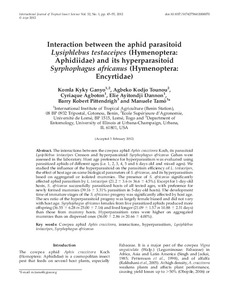| dc.contributor.author | Ganyo, K.K. |
| dc.contributor.author | Tounou, A.K. |
| dc.contributor.author | Agboton, C. |
| dc.contributor.author | Dannon, E.A. |
| dc.contributor.author | Pittendrigh, Barry R. |
| dc.contributor.author | Tamo, M. |
| dc.date.accessioned | 2019-12-04T11:04:22Z |
| dc.date.available | 2019-12-04T11:04:22Z |
| dc.date.issued | 2012 |
| dc.identifier.citation | Ganyo, K.K., Tounou, A.K., Agboton, C., Dannon, E., Pittendrigh, B.R. & Tamo, M. (2012). Interaction between the aphid parasitoid Lysiphlebus testaceipes (Hymenoptera: Aphidiidae) and its hyperparasitoid Syrphophagus africanus (Hymenoptera: Encyrtidae). International Journal of Tropical Insect Science, 32(01), 45-55. |
| dc.identifier.issn | 1742-7584 |
| dc.identifier.uri | https://hdl.handle.net/20.500.12478/1409 |
| dc.description.abstract | The interactions between the cowpea aphid Aphis craccivora Koch, its parasitoid Lysiphlebus testaceipes Cresson and hyperparasitoid Syrphophagus africanus Gahan were assessed in the laboratory. Host age preference for hyperparasitism was evaluated using parasitized aphids of different ages (i.e. 1, 2, 3, 4, 5 and 6 days old and mixed ages). We studied the influence of the hyperparasitoid on the parasitism efficiency of L. testaceipes, the effect of host age on some biological parameters of S. africanus, and its hyperparasitism based on aggregated or isolated mummies. The presence of S. africanus significantly affected aphid parasitism by L. testaceipes (21.2 ^ 3.6 vs 36.6 ^ 4.5%). Except for 1-day-old hosts, S. africanus successfully parasitized hosts of all tested ages, with preference for newly formed mummies (39.16 ^ 3.31% parasitism in 5-day-old hosts). The development time of immature stages of the S. africanus progeny was significantly affected by host age. The sex ratio of the hyperparasitoid progeny was largely female biased and did not vary with host age. Syrphophagus africanus females from live parasitized aphids produced more offspring (36.55 ^ 6.28 vs 25.00 ^ 7.16) and lived longer (21.09 ^ 1.57 vs 10.88 ^ 2.31 days) than those from mummy hosts. Hyperparasitism rates were higher on aggregated mummies than on dispersed ones (36.00 ^ 2.86 vs 20.66 ^ 4.00%). |
| dc.description.sponsorship | United States Agency for International Development |
| dc.format.extent | 45–55 |
| dc.language.iso | en |
| dc.subject | Lysiphlebus |
| dc.subject | Hyperparasitism |
| dc.subject | Aphid |
| dc.subject | Aphis |
| dc.subject | Cowpeas |
| dc.title | Interaction between the aphid parasitoid Lysiphlebus testaceipes (Hymenoptera: Aphidiidae) and its hyperparasitoid Syrphophagus africanus (Hymenoptera: Encyrtidae) |
| dc.type | Journal Article |
| dc.description.version | Peer Review |
| cg.contributor.crp | Grain Legumes |
| cg.contributor.affiliation | International Institute of Tropical Agriculture |
| cg.contributor.affiliation | Université de Lomé |
| cg.contributor.affiliation | University of Illinois |
| cg.coverage.region | Africa |
| cg.coverage.region | West Africa |
| cg.coverage.country | Benin |
| cg.isijournal | ISI Journal |
| cg.authorship.types | CGIAR and developing country institute |
| cg.iitasubject | Cowpea |
| cg.iitasubject | Grain Legumes |
| cg.journal | International Journal of Tropical Insect Science |
| cg.howpublished | Formally Published |
| cg.accessibilitystatus | Limited Access |
| local.dspaceid | 79550 |
| cg.identifier.doi | https://dx.doi.org/10.1017/S1742758412000070 |

